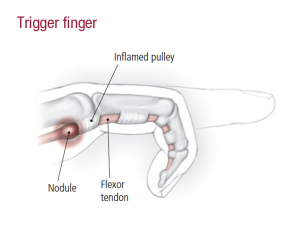Taking Aim at Trigger Finger Pain: Know Your Treatment Options
 “Trigger finger” may sound like an odd name for medical problem, but it’s actually pretty accurate: In its advanced stages, trigger finger causes your finger to stay in a bent position, similar to the position your finger would be in when pulling the trigger on a firearm. It’s medical name is a bit more difficult to remember – stenosing tenosynovitis – but whatever name you use, there’s no denying it can be debilitating and painful.
“Trigger finger” may sound like an odd name for medical problem, but it’s actually pretty accurate: In its advanced stages, trigger finger causes your finger to stay in a bent position, similar to the position your finger would be in when pulling the trigger on a firearm. It’s medical name is a bit more difficult to remember – stenosing tenosynovitis – but whatever name you use, there’s no denying it can be debilitating and painful.
Trigger Finger Causes
Trigger finger occurs when inflammation inside your hand prevents your joint from moving normally. Specifically, it’s caused by swelling around the tendons that control your finger movement. When you bend (or straighten) your finger, the tendons inside your hand flex or stretch, enabling your joint to move. Each tendon is surrounded by a protective sheath of smooth tissue called the synovial membrane. This tissue forms a sort of tunnel that allows the tendon to move freely and without friction. Trigger finger occurs when inflammation narrows this tunnel, making it harder for the tendon to move freely.
Anyone can develop trigger finger, but it’s more common among certain groups of individuals, including people with diabetes or rheumatoid arthritis and people whose jobs or hobbies require a lot of repetitive gripping.
Symptoms of Trigger Finger
The symptoms of trigger finger can vary, depending on the severity of the swelling or other damage inside your hand. The most common symptoms include:
- tenderness or swelling at the base of the finger
- finger joint stiffness or difficulty bending your finger
- a clicking or snapping sensation or a “popping” noise when you bend your finger
- the sensation of catching or “sticking” in the joint when your finger is bent or straightened
Initially, these symptoms may be temporary. But over time, the joint can become locked into a bent position, making simple activities like holding a cup or typing far more difficult and uncomfortable.
Treating Trigger Finger
Trigger finger treatment typically begins with nonsurgical interventions, like stretching exercises and splinting. Injections of corticosteroids also may be used to help relieve inflammation and swelling in and around the tendon and joint. When these approaches don’t provide relief or when trigger finger is especially severe, surgery may be needed to release the constricting area of sheath that pinches the tendon preventing it from gliding smoothly. This restores normal motion in the finger. There are two primary approaches to surgical treatment:
Percutaneous Release
In this procedure, your palm is numbed and a long needle is used to gently break apart tissue that’s preventing the tendon from moving normally. Ultrasound may be used to ensure proper placement of the needle.
Open Surgery
This approach uses a small incision made at the base of your finger. During the procedure, the surgeon makes a cut into the affected portion of the tendon sheath, releasing the area of constriction so the tendon can move freely again.
Both percutaneous release and open surgery can be performed on an outpatient basis, typically with local anesthetics.
Get relief for trigger finger pain.
Like other joint problems, trigger finger can become much worse without prompt, professional treatment. If you’ve been experiencing finger joint stiffness, joint “sticking” or other symptoms when you bend or flex your fingers, scheduling an exam is the first step toward preventing more serious damage. As a top hand specialist helping patients in Illinois, southern Wisconsin and western Iowa, Dr. Bear is skilled in state-of-the-art techniques for diagnosing and treating trigger finger and other conditions and diseases affecting the fingers, wrist , hand, elbow and shoulder.
 To learn more about the care and treatment options that can help you feel – and move – better, call OrthoIllinois at 815-398-9491 and schedule an appointment with Dr. Bear today.
To learn more about the care and treatment options that can help you feel – and move – better, call OrthoIllinois at 815-398-9491 and schedule an appointment with Dr. Bear today.


